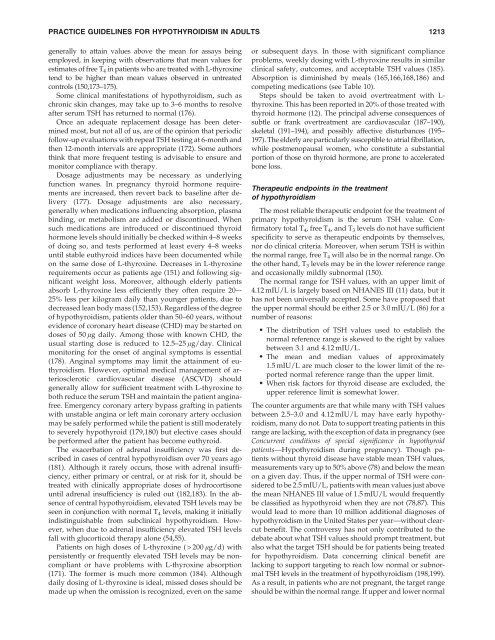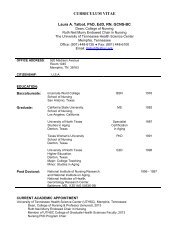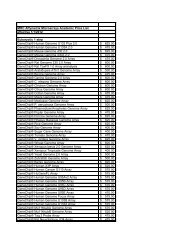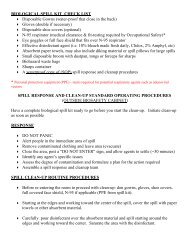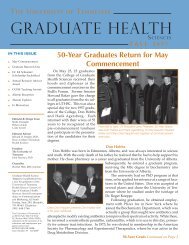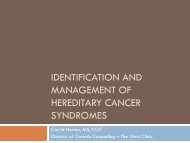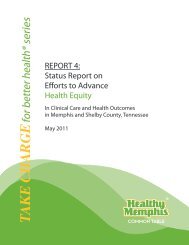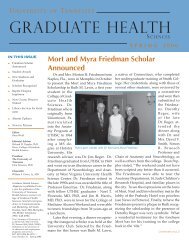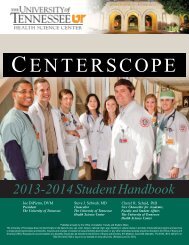Clinical Practice Guidelines for Hypothyroidism in Adults ...
Clinical Practice Guidelines for Hypothyroidism in Adults ...
Clinical Practice Guidelines for Hypothyroidism in Adults ...
You also want an ePaper? Increase the reach of your titles
YUMPU automatically turns print PDFs into web optimized ePapers that Google loves.
PRACTICE GUIDELINES FOR HYPOTHYROIDISM IN ADULTS 1213generally to atta<strong>in</strong> values above the mean <strong>for</strong> assays be<strong>in</strong>gemployed, <strong>in</strong> keep<strong>in</strong>g with observations that mean values <strong>for</strong>estimates of free T 4 <strong>in</strong> patients who are treated with L-thyrox<strong>in</strong>etend to be higher than mean values observed <strong>in</strong> untreatedcontrols (150,173–175).Some cl<strong>in</strong>ical manifestations of hypothyroidism, such aschronic sk<strong>in</strong> changes, may take up to 3–6 months to resolveafter serum TSH has returned to normal (176).Once an adequate replacement dosage has been determ<strong>in</strong>edmost, but not all of us, are of the op<strong>in</strong>ion that periodicfollow-up evaluations with repeat TSH test<strong>in</strong>g at 6-month andthen 12-month <strong>in</strong>tervals are appropriate (172). Some authorsth<strong>in</strong>k that more frequent test<strong>in</strong>g is advisable to ensure andmonitor compliance with therapy.Dosage adjustments may be necessary as underly<strong>in</strong>gfunction wanes. In pregnancy thyroid hormone requirementsare <strong>in</strong>creased, then revert back to basel<strong>in</strong>e after delivery(177). Dosage adjustments are also necessary,generally when medications <strong>in</strong>fluenc<strong>in</strong>g absorption, plasmab<strong>in</strong>d<strong>in</strong>g, or metabolism are added or discont<strong>in</strong>ued. Whensuch medications are <strong>in</strong>troduced or discont<strong>in</strong>ued thyroidhormone levels should <strong>in</strong>itially be checked with<strong>in</strong> 4–8 weeksof do<strong>in</strong>g so, and tests per<strong>for</strong>med at least every 4–8 weeksuntil stable euthyroid <strong>in</strong>dices have been documented whileonthesamedoseofL-thyrox<strong>in</strong>e.Decreases<strong>in</strong>L-thyrox<strong>in</strong>erequirements occur as patients age (151) and follow<strong>in</strong>g significantweight loss. Moreover, although elderly patientsabsorb L-thyrox<strong>in</strong>e less efficiently they often require 20–-25% less per kilogram daily than younger patients, due todecreased lean body mass (152,153). Regardless of the degreeof hypothyroidism, patients older than 50–60 years, withoutevidence of coronary heart disease (CHD) may be started ondoses of 50 lg daily. Among those with known CHD, theusual start<strong>in</strong>g dose is reduced to 12.5–25 lg/day. <strong>Cl<strong>in</strong>ical</strong>monitor<strong>in</strong>g <strong>for</strong> the onset of ang<strong>in</strong>al symptoms is essential(178). Ang<strong>in</strong>al symptoms may limit the atta<strong>in</strong>ment of euthyroidism.However, optimal medical management of arterioscleroticcardiovascular disease (ASCVD) shouldgenerally allow <strong>for</strong> sufficient treatment with L-thyrox<strong>in</strong>e toboth reduce the serum TSH and ma<strong>in</strong>ta<strong>in</strong> the patient ang<strong>in</strong>afree.Emergency coronary artery bypass graft<strong>in</strong>g <strong>in</strong> patientswith unstable ang<strong>in</strong>a or left ma<strong>in</strong> coronary artery occlusionmay be safely per<strong>for</strong>med while the patient is still moderatelyto severely hypothyroid (179,180) but elective cases shouldbe per<strong>for</strong>med after the patient has become euthyroid.The exacerbation of adrenal <strong>in</strong>sufficiency was first described<strong>in</strong> cases of central hypothyroidism over 70 years ago(181). Although it rarely occurs, those with adrenal <strong>in</strong>sufficiency,either primary or central, or at risk <strong>for</strong> it, should betreated with cl<strong>in</strong>ically appropriate doses of hydrocortisoneuntil adrenal <strong>in</strong>sufficiency is ruled out (182,183). In the absenceof central hypothyroidism, elevated TSH levels may beseen <strong>in</strong> conjunction with normal T 4 levels, mak<strong>in</strong>g it <strong>in</strong>itially<strong>in</strong>dist<strong>in</strong>guishable from subcl<strong>in</strong>ical hypothyroidism. However,when due to adrenal <strong>in</strong>sufficiency elevated TSH levelsfall with glucorticoid therapy alone (54,55).Patients on high doses of L-thyrox<strong>in</strong>e ( > 200 lg/d) withpersistently or frequently elevated TSH levels may be noncompliantor have problems with L-thyrox<strong>in</strong>e absorption(171). The <strong>for</strong>mer is much more common (184). Althoughdaily dos<strong>in</strong>g of L-thyrox<strong>in</strong>e is ideal, missed doses should bemade up when the omission is recognized, even on the sameor subsequent days. In those with significant complianceproblems, weekly dos<strong>in</strong>g with L-thyrox<strong>in</strong>e results <strong>in</strong> similarcl<strong>in</strong>ical safety, outcomes, and acceptable TSH values (185).Absorption is dim<strong>in</strong>ished by meals (165,166,168,186) andcompet<strong>in</strong>g medications (see Table 10).Steps should be taken to avoid overtreatment with L-thyrox<strong>in</strong>e. This has been reported <strong>in</strong> 20% of those treated withthyroid hormone (12). The pr<strong>in</strong>cipal adverse consequences ofsubtle or frank overtreatment are cardiovascular (187–190),skeletal (191–194), and possibly affective disturbances (195–197). The elderly are particularly susceptible to atrial fibrillation,while postmenopausal women, who constitute a substantialportion of those on thyroid hormone, are prone to acceleratedbone loss.Therapeutic endpo<strong>in</strong>ts <strong>in</strong> the treatmentof hypothyroidismThe most reliable therapeutic endpo<strong>in</strong>t <strong>for</strong> the treatment ofprimary hypothyroidism is the serum TSH value. Confirmatorytotal T 4 , free T 4 , and T 3 levels do not have sufficientspecificity to serve as therapeutic endpo<strong>in</strong>ts by themselves,nor do cl<strong>in</strong>ical criteria. Moreover, when serum TSH is with<strong>in</strong>the normal range, free T 4 will also be <strong>in</strong> the normal range. Onthe other hand, T 3 levels may be <strong>in</strong> the lower reference rangeand occasionally mildly subnormal (150).The normal range <strong>for</strong> TSH values, with an upper limit of4.12 mIU/L is largely based on NHANES III (11) data, but ithas not been universally accepted. Some have proposed thatthe upper normal should be either 2.5 or 3.0 mIU/L (86) <strong>for</strong> anumber of reasons: The distribution of TSH values used to establish thenormal reference range is skewed to the right by valuesbetween 3.1 and 4.12 mIU/L. The mean and median values of approximately1.5 mIU/L are much closer to the lower limit of the reportednormal reference range than the upper limit. When risk factors <strong>for</strong> thyroid disease are excluded, theupper reference limit is somewhat lower.The counter arguments are that while many with TSH valuesbetween 2.5–3.0 and 4.12 mIU/L may have early hypothyroidism,many do not. Data to support treat<strong>in</strong>g patients <strong>in</strong> thisrange are lack<strong>in</strong>g, with the exception of data <strong>in</strong> pregnancy (seeConcurrent conditions of special significance <strong>in</strong> hypothyroidpatients—<strong>Hypothyroidism</strong> dur<strong>in</strong>g pregnancy). Though patientswithout thyroid disease have stable mean TSH values,measurements vary up to 50% above (78) and below the meanon a given day. Thus, if the upper normal of TSH were consideredto be 2.5 mIU/L, patients with mean values just abovethe mean NHANES III value of 1.5 mIU/L would frequentlybe classified as hypothyroid when they are not (78,87). Thiswould lead to more than 10 million additional diagnoses ofhypothyroidism <strong>in</strong> the United States per year—without clearcutbenefit. The controversy has not only contributed to thedebate about what TSH values should prompt treatment, butalso what the target TSH should be <strong>for</strong> patients be<strong>in</strong>g treated<strong>for</strong> hypothyroidism. Data concern<strong>in</strong>g cl<strong>in</strong>ical benefit arelack<strong>in</strong>g to support target<strong>in</strong>g to reach low normal or subnormalTSH levels <strong>in</strong> the treatment of hypothyroidism (198,199).As a result, <strong>in</strong> patients who are not pregnant, the target rangeshould be with<strong>in</strong> the normal range. If upper and lower normal


